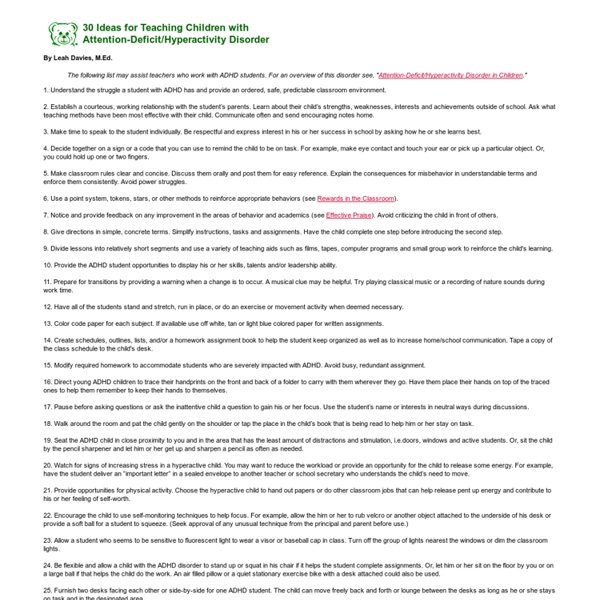30 Ideas for Teaching Children with Attention-Deficit/Hyperactivity Disorder by Leah Davies, M.Ed.
By Leah Davies, M.Ed. The following list may assist teachers who work with ADHD students. For an overview of this disorder see, "Attention-Deficit/Hyperactivity Disorder in Children." 1. Understand the struggle a student with ADHD has and provide an ordered, safe, predictable classroom environment. 2. 3. 4. 5. 6. 7. 8. 9. 10. 11. 12. 13. 14. 15. 16. 17. 18. 19. 20. 21. 22. 23. 24. 25. 26. 27. 28. 29. 30. inShare
Some Types of Learning Disabilities
Some Types of Learning Disabilities — The First Step is Understanding Some types of learning disabilities can be "treated" through proper testing and training. The key is to identify the specific cognitive weaknesses causing the "disorder" and strengthen those cognitive skills through dynamic, one-on-one training and practice. For the parent, the first step is to understand the types of learning disabilities that may be affecting your child. Some Types of Learning Disabilities — General Processing Issues Some types of learning disabilities are categorized by the cognitive processing problem. This means your child may have issues with one of the following: Attention — The ability to stay on task in a sustained, selective, or divided way. Working Memory — The ability to retain and process information for short time periods. Processing Speed — The rate at which the brain handles information. Long-Term Memory — The ability to both store and recall information for later use.
Special Education Web Site – Parents With Children in Special Education NAPCSE
ADD / ADHD and School: Helping Children with ADHD Succeed at School
Setting up your child for school success The classroom environment can be a challenging place for a child with ADD/ADHD. The very tasks these students find the most difficult—sitting still, listening quietly, concentrating—are the ones they are required to do all day long. Perhaps most frustrating of all is that most these children want to be able to learn and behave like their unaffected peers. As a parent, you can help your child cope with these deficits and meet the challenges school creates. ADD / ADHD and school: Tips for supporting teachers Remember that your child’s teacher has a full plate: in addition to managing a group of children with distinct personalities and learning styles, he or she can also expect to have at least one student with ADD/ADHD. There are a number of ways you can work with teachers to keep your child on track at school. ADD / ADHD school support strategy 1: Communicate with school and teachers As a parent, you are your child’s advocate. Plan ahead.
Math, English programs, games, worksheets for grades K-8 - Dositey.com educational site
Enjoy a wide range of lessons, practice exercises, step-by-step tutorials, and printable worksheets... Try today: Grades K-2: Phonics, Adding Same Numbers, Beginning Fractions Grades 3-4: Thousands, Order of Operations Grades 5-8: Reading, Naming, and Writing Decimals
ADE Special Education | Home
Learning Disabilities in Children: Symptoms, Types, and Testing
What are learning disabilities? Learning disabilities, or learning disorders, are an umbrella term for a wide variety of learning problems. A learning disability is not a problem with intelligence or motivation. Kids with learning disabilities aren’t lazy or dumb. Simply put, children and adults with learning disabilities see, hear, and understand things differently. Children with learning disabilities can, and do, succeed It can be tough to face the possibility that your child has a learning disorder. But the important thing to remember is that most kids with learning disabilities are just as smart as everyone else. Signs and symptoms of learning disabilities and disorders If you're worried, don't wait If you suspect that your child's learning difficulties may require special assistance, please do not delay in finding support. Learning disabilities look very different from one child to another. It’s not always easy to identify learning disabilities. Related Articles Resources & References
Developing Reading skills
There is always a debate about teaching reading at F.E level to students with a learning disability(i.e teach them to use the skills they already have rather than learning using phonics) If you do want to have a go at using phonics and teaching tricky words here are some links to help you: A guide from DFES Letters and Sounds guidance from Department of EducationAn introduction to synthetic phonics from dyslexics.org.uk An over view of how and when to introduce the sounds and words can be found at: Phonics Play . DFES A contibutor to the TES website has listed all the key words in phase order TES High Frequency Words in phase order And here are a few resources for teaching phonics at the early stages. Phase 2 Decodable words Games for the interactive whiteboard from TES I board (now have to pay to access) covering letter sounds in phase 1 and 2 developing Grapheme Phoneme Correspondence mainly as, at, pat, sat, tap TES Letters and sounds phase 1 and 2 .
Ticket To Read®
Apps in Education
tweenteacher.com
Related:
Related:



